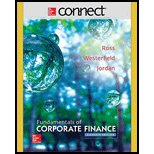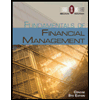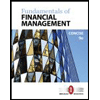
Sustainable Growth Rate [LO3] In the chapter, we discussed the two versions of the sustainable growth rate formula. Derive the formula
To determine: The internal growth rate is
Introduction:
ROA (return on assets) indicates the operating efficiency of the firm and using ROA the internal growth of firm can be determined. ROE (return on equity) measures the amount of profit, which can be derived from the shareholder’s equity and using ROE the sustainable growth rate of the firm can be determined.
Explanation of Solution
Given information:
ROE is based on the beginning of period equity.
Assumption: The beginning of period equity as x, which represents (ROEx) and the end of period equity as y, which represents (ROEy)
Formulae:
The formula to compute the sustainable growth rate:
Where,
b refers to the retention ratio
The formula to compute the internal growth rate:
Derive
Here, NI is net income and TE is total equity.
Substitute
Multiply
Where, the beginning of period equity is
The below equation is arrived by substituting equation 3 in equation 2.
Rewrite it as
Therefore,
Hence, the sustainable growth rate equation is
Compute
Where, TA is total assets
Multiply, internal growth rate with
Where,
The beginning of period equity is
Therefore,
Substitute,
Hence, the equation of internal growth rate is
Want to see more full solutions like this?
Chapter 4 Solutions
Connect 1 Semester Access Card for Fundamentals of Corporate Finance
- How does the weighted average cost of capital (WACC) impact investment decisions?need help.arrow_forwardHow does the weighted average cost of capital (WACC) impact investment decisions?arrow_forwardWhat is the difference between operating leverage and financial leverage in finance? explainarrow_forward
 Intermediate Financial Management (MindTap Course...FinanceISBN:9781337395083Author:Eugene F. Brigham, Phillip R. DavesPublisher:Cengage Learning
Intermediate Financial Management (MindTap Course...FinanceISBN:9781337395083Author:Eugene F. Brigham, Phillip R. DavesPublisher:Cengage Learning Fundamentals of Financial Management, Concise Edi...FinanceISBN:9781285065137Author:Eugene F. Brigham, Joel F. HoustonPublisher:Cengage Learning
Fundamentals of Financial Management, Concise Edi...FinanceISBN:9781285065137Author:Eugene F. Brigham, Joel F. HoustonPublisher:Cengage Learning Fundamentals of Financial Management, Concise Edi...FinanceISBN:9781305635937Author:Eugene F. Brigham, Joel F. HoustonPublisher:Cengage Learning
Fundamentals of Financial Management, Concise Edi...FinanceISBN:9781305635937Author:Eugene F. Brigham, Joel F. HoustonPublisher:Cengage Learning



